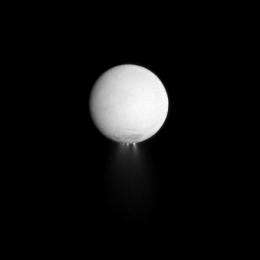Upcoming flybys could provide clues to Enceladus interior

What is going on inside Saturn’s moon Enceladus and what powers the icy geysers and jets? A pair of upcoming flybys by the Cassini spacecraft could help answer those questions. Radio instruments on board will measure the gravity field of Enceladus and focus particularly on the very intriguing south polar hot spot.
Of course, the success of these flybys hinges on the Cassini mission controllers being able to wake up the dormant spacecraft which has been in safe mode since November 2. Teams will attempt to get Cassini up and running again tomorrow, November 24, and they don’t anticipate any problems.
Cassini went into the protective standby mode and the likely cause of the problem was a faulty program code line, or a flipped bit in the spacecraft’s command and data system computer.
The upcoming flybys of Enceladus will put Cassini very close – about 48 kilometers (30 miles) above the surface. The first will take place on November 30. Pairing this flyby with one on April 28, should provide scientists enough information to determine the nature of the interior right under the hot spot. The next flyby on December 21, Cassini will make 50-kilometer pass over the north pole of Enceladus. The fields and particles instruments will be trying to “sniff” anything coming from the moon.
There will be two three-hour “wing” observations before and after closest-approach (from five to eight hours from closest approach on either side), and then three more hours centered directly around closest approach. The Cassini team is throwing almost the entire gamut of instruments into the flyby program, between radio science (RSS) observations, the imaging science system (ISS) and composite infrared spectrometer (CIRS) which will observe this moon on the inbound leg, and CIRS and the visible and infrared mapping spectrometer (VIMS) which will take data on the outbound leg, with other optical remote sensing and fields, particles and waves instruments also taking data.
More information: saturn.jpl.nasa.gov/mission/saturntourdates/
Source: Universe Today





















